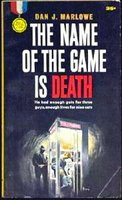 bubbling with sarcastic wit and, of course, is a great man for the women.” However, it was Marlowe’s 1962 novel, The Name of the Game Is Death, introducing killer, bank robber, and definitive “anti-hero” Earl Drake, that really launched his career.
bubbling with sarcastic wit and, of course, is a great man for the women.” However, it was Marlowe’s 1962 novel, The Name of the Game Is Death, introducing killer, bank robber, and definitive “anti-hero” Earl Drake, that really launched his career.Bill Pronzini has said that Name of the Game is “about as good as original paperback writing can get.” It was that same gangster story-cum-detective yarn that brought Marlowe to the attention Al Nussbaum, an early 1960s bank robber serving a 40-year stint in federal stir. Explains Hoffmann: “[Nussbaum] was so impressed by the book that he got in touch with the author through the publishers. After his arrest he wrote to Marlowe from jail. Marlowe then visited Nussbaum, got to know him, and wrote about him. This resulted in a life-long friendship.” According to Mike Ashley’s The Mammoth Encyclopedia of Modern Crime Fiction (2002), “in a succession of letters, [Nussbaum gave Marlowe] the inside dope on safe-cracking, ballistics, alarm systems--the works. Thereafter, [Marlowe’s] books became so authentic that he had to dumb them down rather than be charged with writing a do-it-yourself bank-robbing guide.” The Endless Hour (1969), which reintroduced Drake--after having undergone cosmetic surgery, and now pitting himself against the Mafia (Ashley calls him “an honorable villain, if there is such a thing”)--clearly demonstrates the influence of this newly gained criminal knowledge. In Flashpoint (1970), which won an Edgar Award for Best Paperback Original, Drake becomes an undercover agent for the U.S. government, a job he then held through eight more books--until author Marlowe suffered a major stroke in 1969 that “damaged his memory. He no longer knew who he was, where he lived, what he had done before, etc.,” writes Hoffmann. “All of his personal memory was gone.” However, Marlowe’s “writing and language abilities ... were still intact,” and allowed him to continue penning short stories, if not longer novels--with Nussbaum’s assistance.
For Mystery*File, Hoffmann recounts in much further detail Marlowe’s now largely forgotten career, while Bill Crider offers a companion piece exalting this author’s history as a “seriously under-rated Gold Medal writer.” Both are well worth reading, especially if (as is the case for me, I confess) you’ve never read Marlowe’s work.
* * *
By the way, readers interested in pulpish mysteries and Cold War-era spy fiction should check out Bruce Grossman’s “Bullets, Broads, Blackmail & Bombs” column, featured on the Bookgasm site. While his latest installment looks at Donald Hamilton’s Matt Helm books, previous columns have focused on Mickey Spillane, James Bond-less espionage novels (see here and here), and some very readable books with trashy covers.READ MORE: “The Name of the Game Is Marlowe,” by Duane Swierczynski (Secret Dead Blog); “Dan J. Marlowe’s The Name of the Game Is Death,” by Steve Lewis (Mystery*File).

















No comments:
Post a Comment